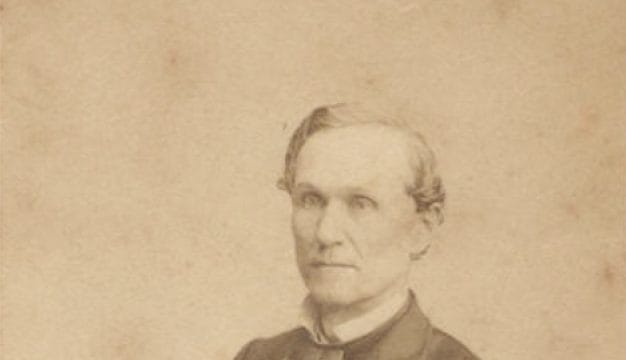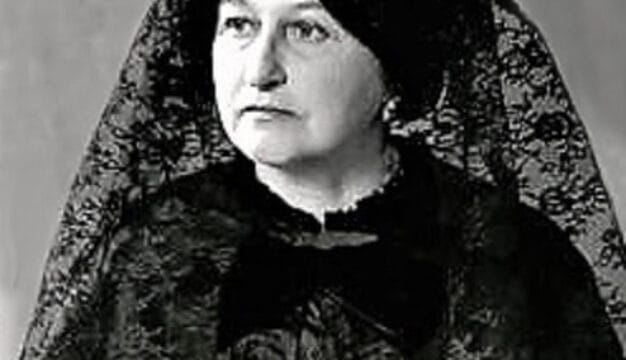MuscleShoals Sound Studio
From its establishment in 1969 by the Muscle Shoals Rhythm Section (MSRS) until the mid-1980s, the Muscle Shoals Sound Studio (MSSS) in Sheffield, Colbert County, was one of the most sought-after recording studios in the nation. The musical legacy of the recordings made at the studio rivals the “sounds” of Detroit, Memphis, and Philadelphia.
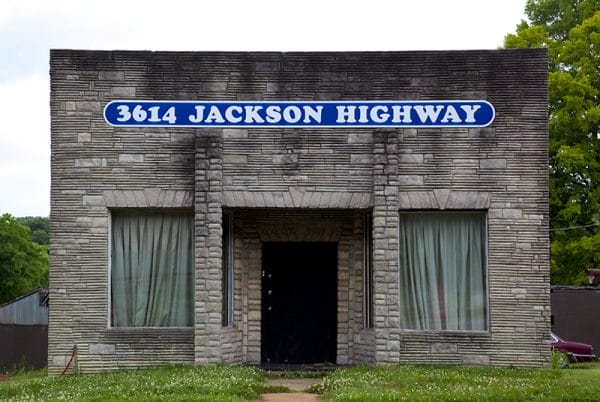 MuscleShoals Sound Studio
In March 1969, members of the MSRS—Barry Beckett (keyboards), Roger Hawkins (drums), David Hood (bass), and Jimmy Johnson (guitar)—severed their ties with FAME Studios (Florence Alabama Music Enterprises) in Muscle Shoals and organized their own music production facility, Muscle Shoals Sound Studio, Inc. Hawkins and Johnson had envisioned opening a studio for some time and were interested in purchasing a building at 3614 Jackson Highway in Sheffield, which already housed a studio. The four musicians combined their resources and purchased the building and installed an eight-track recording machine compatible with Atlantic Records’ recording equipment, with important financial assistance from Atlantic Records’ vice president Jerry Wexler, who wanted the quartet available for his projects.
MuscleShoals Sound Studio
In March 1969, members of the MSRS—Barry Beckett (keyboards), Roger Hawkins (drums), David Hood (bass), and Jimmy Johnson (guitar)—severed their ties with FAME Studios (Florence Alabama Music Enterprises) in Muscle Shoals and organized their own music production facility, Muscle Shoals Sound Studio, Inc. Hawkins and Johnson had envisioned opening a studio for some time and were interested in purchasing a building at 3614 Jackson Highway in Sheffield, which already housed a studio. The four musicians combined their resources and purchased the building and installed an eight-track recording machine compatible with Atlantic Records’ recording equipment, with important financial assistance from Atlantic Records’ vice president Jerry Wexler, who wanted the quartet available for his projects.
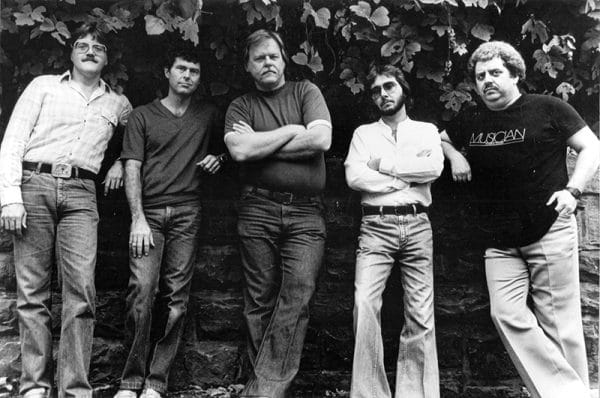 MSRS with Randy McCormick
The studio maintained its own staff of writers and engineers. Although recording artists frequently brought their own producers, much of the production work was done by the Muscle Shoals Rhythm Section’s members themselves (often garnering co-production credits), as was the case in their work with Bob Seger and Paul Simon. The quartet was also joined by a host of songwriters, including George Jackson, Randy McCormick, and Phillip Mitchell (signed to Muscle Shoals Sound Publishing Company), and producers such as Al Bell, Ahmet Ertegun, Glenn Frey, Johnny Sandlin, Jerry Wexler, and Bobby Womack.
MSRS with Randy McCormick
The studio maintained its own staff of writers and engineers. Although recording artists frequently brought their own producers, much of the production work was done by the Muscle Shoals Rhythm Section’s members themselves (often garnering co-production credits), as was the case in their work with Bob Seger and Paul Simon. The quartet was also joined by a host of songwriters, including George Jackson, Randy McCormick, and Phillip Mitchell (signed to Muscle Shoals Sound Publishing Company), and producers such as Al Bell, Ahmet Ertegun, Glenn Frey, Johnny Sandlin, Jerry Wexler, and Bobby Womack.
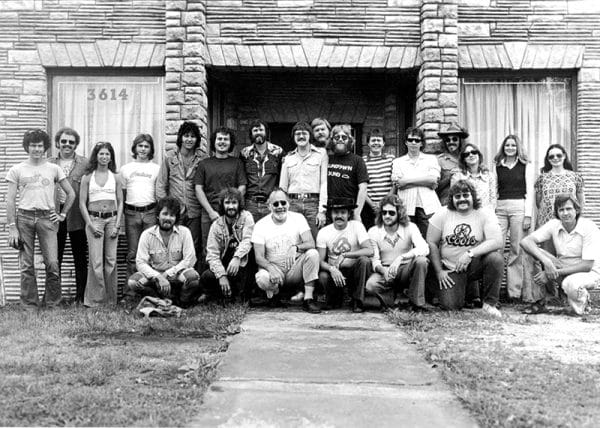 Muscle Shoals Sound Studio
The musicians of the MSSS wanted a name that would distinguish their studio from FAME and that would promote their all-important “sound.” In the late 1960s, independent regional recording was at its zenith. Detroit, Philadelphia, Nashville, and Memphis were all home to studios with distinct identities like the “Motown Sound,” “TSOP, the sound of Philadelphia,” and Memphis’s “Stax sound.” And so members of the former FAME rhythm section renamed themselves the Muscle Shoals Sound Rhythm Section, simultaneously laying claim to a regional identity and eclipsing FAME’s indirect local association with Florence. Such a regional identifier signified to the world the intellectual property of the collaborating entrepreneurs of the Jackson Highway studio and has largely remained so, even beyond its era of operation.
Muscle Shoals Sound Studio
The musicians of the MSSS wanted a name that would distinguish their studio from FAME and that would promote their all-important “sound.” In the late 1960s, independent regional recording was at its zenith. Detroit, Philadelphia, Nashville, and Memphis were all home to studios with distinct identities like the “Motown Sound,” “TSOP, the sound of Philadelphia,” and Memphis’s “Stax sound.” And so members of the former FAME rhythm section renamed themselves the Muscle Shoals Sound Rhythm Section, simultaneously laying claim to a regional identity and eclipsing FAME’s indirect local association with Florence. Such a regional identifier signified to the world the intellectual property of the collaborating entrepreneurs of the Jackson Highway studio and has largely remained so, even beyond its era of operation.
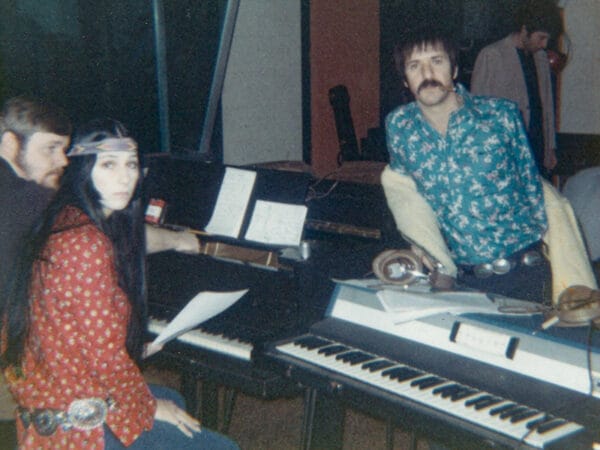 Barry Beckett with Sonny and Cher
The studio opened in early April 1969 recording Cher’s Atco album aptly titled 3614 Jackson Highway. Although it was housed in an undistinguished gray stone building, the façade is immediately recognizable to music fans of that era. The cover of Cher’s album portrayed the artists standing confidently before the studio, and dozens of similar photographs would be shot of session participants at Muscle Shoals Sound, whether for album art, such as Paul Simon’s 1973 There Goes Rhymin’ Simon and Donnie Fritts‘s 1974 Prone to Lean, or for the music press. The photographs surprised many listeners, who assumed MSRS members were African American. The “sound” associated with Muscle Shoals, because of its rhythm and blues roots, is racially ambiguous, and the MSRS often collaborated with black artists and producers in ways that defied accepted societal standards on race relations in the South.
Barry Beckett with Sonny and Cher
The studio opened in early April 1969 recording Cher’s Atco album aptly titled 3614 Jackson Highway. Although it was housed in an undistinguished gray stone building, the façade is immediately recognizable to music fans of that era. The cover of Cher’s album portrayed the artists standing confidently before the studio, and dozens of similar photographs would be shot of session participants at Muscle Shoals Sound, whether for album art, such as Paul Simon’s 1973 There Goes Rhymin’ Simon and Donnie Fritts‘s 1974 Prone to Lean, or for the music press. The photographs surprised many listeners, who assumed MSRS members were African American. The “sound” associated with Muscle Shoals, because of its rhythm and blues roots, is racially ambiguous, and the MSRS often collaborated with black artists and producers in ways that defied accepted societal standards on race relations in the South.
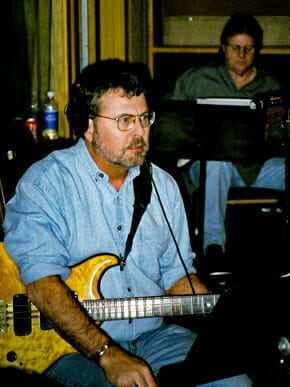 David Hood and Reggie Young
After a rocky start-up year, when projects trickled in and songs performed poorly in the charts, activity virtually exploded at the studio. Early sessions with Lulu, Solomon Burke, John Hammond Jr., Ronnie Hawkins, and The Duck and The Bea enabled the studio to solidify its sound. Coinciding with the commercial success of R. B. Greaves’ hit “Take a Letter, Maria,” recorded at MSSS in August 1969, the Rolling Stones recorded three songs at Muscle Shoals Sound Studio—”Brown Sugar,” “Wild Horses,” and “You Gotta Move”—in early December 1969, before performing at their infamous concert at Altamont, California. Another notable early recording session that features the studio as a prominent physical presence in terms of its identity and sound is the collection titled Skynyrd’s First: The Complete Muscle Shoals Sessions. Johnson produced those seminal recordings of southern-rock icons Lynyrd Skynyrd in 1971 and 1972; tracks collected on that album were later reissued in 1998.
David Hood and Reggie Young
After a rocky start-up year, when projects trickled in and songs performed poorly in the charts, activity virtually exploded at the studio. Early sessions with Lulu, Solomon Burke, John Hammond Jr., Ronnie Hawkins, and The Duck and The Bea enabled the studio to solidify its sound. Coinciding with the commercial success of R. B. Greaves’ hit “Take a Letter, Maria,” recorded at MSSS in August 1969, the Rolling Stones recorded three songs at Muscle Shoals Sound Studio—”Brown Sugar,” “Wild Horses,” and “You Gotta Move”—in early December 1969, before performing at their infamous concert at Altamont, California. Another notable early recording session that features the studio as a prominent physical presence in terms of its identity and sound is the collection titled Skynyrd’s First: The Complete Muscle Shoals Sessions. Johnson produced those seminal recordings of southern-rock icons Lynyrd Skynyrd in 1971 and 1972; tracks collected on that album were later reissued in 1998.
The studio embarked on a decade-long collaboration with some of the era’s top popular musicians. Performers who recorded at the studio represent some of the most notable and popular recording artists of the 1970s: J. J. Cale, Leon Russell, Jimmy Cliff, Linda Ronstadt, Rod Stewart, Wilson Pickett, James Brown, Willie Nelson, Boz Scaggs, Bobby Womack, Art Garfunkel, and many others.
The studio also held a unique place in the narrative of soul music in the early 1970s. After the house band at Memphis’s Stax Records, Booker T. and the MGs, split up, Stax producers Johnny Baylor, Al Bell, William Bell, and Don Davis began cutting rhythm tracks at Muscle Shoals Sound in fall 1970. During the subsequent five years, a number of Stax artists, including Luther Ingram, Johnnie Taylor, William Bell, Carla Thomas, the Soul Children, and Margie Joseph, recorded their most important hits at MSSS. Highlights from this period included the Staple Singers’ “Respect Yourself” and “I’ll Take You There,” as well as the Beckett and Hawkins production of Mel and Tim’s 1974 “Starting All Over Again.”
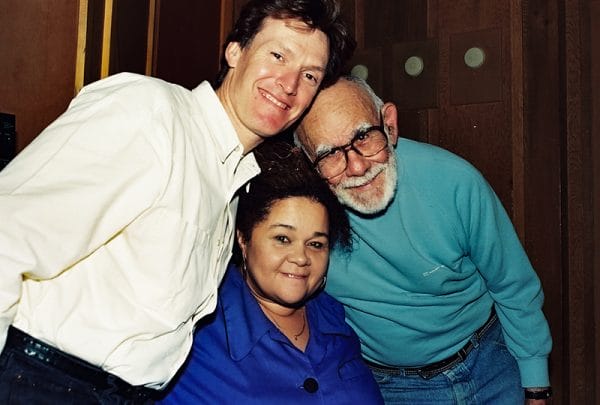 Steve Winwood, Etta James, and Jerry Wexler
During the mid-1970s, MSSS collaborated memorably with numerous artists, such as Bob Seger and Delbert McClinton, and these efforts helped the studio expand to include a music publishing arm and a record label, Muscle Shoals Sound Records. In 1978, the studio moved to a state-of-the-art riverfront facility at 1000 Alabama Avenue in Sheffield. The new building boasted 24-track recording equipment and two studios, where numerous artists, including Levon Helm, Bob Dylan, Dr. Hook, Steve Winwood, Etta James, the Oak Ridge Boys, and Dan Penn recorded. The new studio was sold to Malaco Records in 1985, which in turn sold the building to Cypress Moon Productions Inc., a film studio, in 2005. The original Muscle Shoals Sound Studio at 3614 Jackson Highway was purchased by sound engineer Noel Webster in 1999 and was placed on the National Register of Historic Places on June 2, 2006. The refurbished studio hosted blues-rock band The Black Keys for the recording of their Grammy-winning Brothers album in 2010. In June 2013, Webster sold the studio to the Muscle Shoals Music Foundation, which is headed by Judy Hood, wife of Swamper David Hood. The foundation operates the facility primarily as a museum and offers regular tours, but the studio still functions as a recording space and is available through a proposal submission process.
Steve Winwood, Etta James, and Jerry Wexler
During the mid-1970s, MSSS collaborated memorably with numerous artists, such as Bob Seger and Delbert McClinton, and these efforts helped the studio expand to include a music publishing arm and a record label, Muscle Shoals Sound Records. In 1978, the studio moved to a state-of-the-art riverfront facility at 1000 Alabama Avenue in Sheffield. The new building boasted 24-track recording equipment and two studios, where numerous artists, including Levon Helm, Bob Dylan, Dr. Hook, Steve Winwood, Etta James, the Oak Ridge Boys, and Dan Penn recorded. The new studio was sold to Malaco Records in 1985, which in turn sold the building to Cypress Moon Productions Inc., a film studio, in 2005. The original Muscle Shoals Sound Studio at 3614 Jackson Highway was purchased by sound engineer Noel Webster in 1999 and was placed on the National Register of Historic Places on June 2, 2006. The refurbished studio hosted blues-rock band The Black Keys for the recording of their Grammy-winning Brothers album in 2010. In June 2013, Webster sold the studio to the Muscle Shoals Music Foundation, which is headed by Judy Hood, wife of Swamper David Hood. The foundation operates the facility primarily as a museum and offers regular tours, but the studio still functions as a recording space and is available through a proposal submission process.
The Muscle Shoals sound played a prominent role in American popular music both as a production facility and as a stylistic embodiment of southern regional music. The remarkable consistency of the music created by the Muscle Shoals Rhythm Section can be explained by the synergy of its players and their dedication to the art of recording. Sheffield, a working-class town, fostered a country-soul style and work ethic that was reflected in the studio’s recordings. The appeal of that sound, which is internationally recognized, can be understood as a unique blending of local musical sensibilities with a cosmopolitan mix of styles that reached well beyond its geographic boundaries. The studio’s legacy testifies to music’s ability to defy stereotypes and bring disparate groups together.
Additional Resources
Ertegun, Ahmet M., Susan Steinberg, and Bette Midler. Atlantic Records: The House that Ahmet Built. DVD. Burbank, Calif.: Rhino Entertainment, 2007.
Guralnick, Peter. Sweet Soul Music: Rhythm and Blues and the Southern Dream of Freedom. New York: Harper & Row, 1986.
McNutt, Randy. Guitar Towns: A Journey to the Crossroads of Rock ‘n’ Roll. Bloomington: Indiana University Press, 2002.
Peisch, Jeffrey, et al. History of Rock ‘N’ Roll. DVD. 5 discs. Burbank, Calif.: Warner Home Video, 2004.
Ward, Brian. Just My Soul Responding: Rhythm and Blues, Black Consciousness, and Race Relations. Berkeley, Calif.: University of California Press, 1998.
Wexler, Jerry, and David Ritz. Rhythm & The Blues: A Life in American Music. New York: St. Martin’s Press, 1993.

